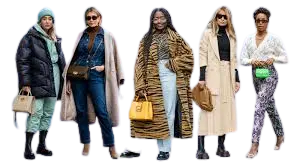Apart from the main clothing, we wear many things for Fashion accessories and safety purposes. We wear fashion accessories on our heads, called Headgear, Headwear, or headdress. It’s a Fashion and clothing element for Fashion, protection, sports, and other needs. To define Headgear, we can tell that any element worn on the head of a Human being is called Headgear/Headwear/ Headdress. In this article, I present the Top 10 Types of Headgear/Headwear/ Headdress you would love to wear.
From practicality to style, headgear comes in an extensive array of designs, each with its unique history and significance. Let’s delve into the diverse types of headgear that have left an indelible mark on various cultures and eras. Headgear, an accessory that transcends mere fashion, has been an integral part of human attire for centuries. From protection against the elements to symbolizing cultural identity, headgear serves multiple purposes across different societies and eras. Let’s delve into the diverse world of headgear, encompassing various types and their significance.
Purposes of wearing Types of Headgear, Headwear or headdress
Headgear/ Headdresses serve various purposes across cultures and contexts, contributing to identity, tradition, and functionality. Here are some everyday purposes behind the use of headdresses:
- Cultural Identity: Headdresses often symbolize cultural identity, representing a specific group, tribe, or community. They convey heritage, traditions, and values, serving as a visual marker of belonging and pride.
- Ceremonial Significance: Many headdresses are worn during religious, ceremonial, or ritualistic occasions. They can signify spiritual connections and social status or mark essential milestones in life, such as weddings, initiations, or festivals.
- Status and Authority: In some societies, certain headdresses are reserved for individuals of high rank or authority, like chiefs, leaders, or royalty. These elaborate headpieces denote power, leadership, and respect within their communities.
- Practical Functionality: Some headdresses serve practical purposes, protecting from elements like sun, rain, or cold weather. They can shield the head and face from harsh conditions, especially in regions with extreme climates.
- Symbolism and Spirituality: Headdresses often incorporate symbolic elements like feathers, beads, or specific colors, representing spiritual beliefs, ancestral connections, or stories passed down through generations.
- Expression of Creativity and Artistry: Many headdresses are intricate works of art, showcasing craftsmanship, creativity, and cultural aesthetics. They serve as a platform for artisans to express cultural motifs, traditional designs, and artistic skills.
- Preservation of Traditions: By wearing headdresses, individuals and communities honor and preserve their cultural heritage. They pass down stories, traditions, and craftsmanship from one generation to the next, ensuring the continuity of their cultural practices.
What are the Top 10 Types of Headgear/Headwear/ Headdress to Wear?
- Hat
- Cap
- Helmet
- Headscarves and Turbans
- Veils and Bonnets
- Crowns and Tiaras
- Headbands and Bandanas
- Fascinators and Headpieces
- Fezzes and Traditional Caps
- Wigs and Hairpieces
Top 10 Different Types of Headgear/Headwear/ Headdress
1. Hat
A hat is a round shape Fashion accessories. Most of the time, women wear this, but men also wear it. A hat refers to headwear that has a circular crown and brim. A hat is used for protection from the sun, warmth, fashion, or as part of a uniform.

2. Cap
Caps, a subtype of hats, are generally characterized by their visors and snug fit. They vary widely—from the sports-centric baseball cap to the more formal flat cap or the military-inspired beret. Caps have evolved from purely functional headgear to iconic fashion statements, representing various affiliations or interests.

3. Helmet
A helmet is a protective element used for defense in different sports and bike riding. Primarily designed for protection, helmets are crucial in various activities, including sports, military, and construction. Motorcycle helmets, football helmets, and combat helmets are just a few examples tailored to specific safety standards and purposes.

4. Headscarves and Turbans
Across many cultures, headscarves and turbans hold deep cultural and religious significance. They are worn for modesty, tradition, or as symbols of faith. Turbans, in particular, vary greatly in style, color, and wrapping techniques, often reflecting regional customs and beliefs.

5. Veils and Bonnets
Veils and bonnets have historical roots and are worn for modesty, religious reasons, or as a protective covering. These accessories have evolved over time but still maintain their significance in various cultures and contexts.

6. Crowns and Tiaras
Royalty and ceremonial occasions often feature crowns and tiaras, representing status, power, and honor. Intricately designed and adorned with precious gemstones, these headpieces symbolize authority and heritage.

7. Headbands and Bandanas
More casual in nature, headbands and bandanas serve both functional and fashion purposes. They keep hair in place during physical activities or add a touch of style to an outfit, showcasing versatility in their usage.

8. Fascinators and Headpieces
Often associated with formal events like weddings or horse races, fascinators and elaborate headpieces are ornate, stylish accessories adorned with feathers, flowers, beads, and other decorative elements, adding glamour and elegance to an ensemble.
9. Fezzes and Traditional Caps
Specific to various cultures, fezzes, kufis, and other traditional caps hold historical and cultural significance. These headpieces often signify religious affiliation, social status, or regional identity, embodying centuries-old traditions and values.

10. Wigs and Hairpieces
Wigs and hairpieces serve both practical and aesthetic purposes. They can conceal hair loss or change one’s appearance dramatically, reflecting historical trends and personal preferences.

Conclusion
Whether for protection, tradition, fashion, or symbolism, the varied types of headgear continue to be both functional and expressive, representing a fusion of practicality and cultural heritage. As trends evolve and traditions persist, headgear remains an enduring and fascinating aspect of human civilization.
Types of Headgear not only shield us from the elements but also reflect cultural heritage, social status, and personal style. From the functional to the ornamental, the evolution of headgear showcases the rich tapestry of human creativity and practicality, making it an enduring and fascinating aspect of fashion and tradition worldwide.
- You would love to read: Difference Between Hat and Cap


